Introduction
Rolling forecasts have revolutionized financial planning, offering a dynamic and proactive approach that outperforms traditional static budgets. In today's volatile economic landscape, organizations need agility, accuracy, and visibility to thrive. Rolling forecasts provide just that.
They enable swift adaptation to changing markets, refine projections for greater accuracy, optimize resource allocation, and grant a clearer view into an organization's financial trajectory. By leveraging historical data and incorporating advanced AI forecasting techniques, businesses can create a resilient financial strategy. This article explores the benefits of rolling forecasts, understanding rolling forecast templates, key components of a rolling forecast, choosing the right time horizon, determining the update frequency, implementing a rolling forecast, best practices, common challenges and solutions, using dedicated FP&A tools, creating a rolling forecast template in Excel, integrating actuals and forecasts, and the importance of variance analysis and continuous improvement.
By adopting these strategies and tools, organizations can navigate the complexities of financial planning and make data-driven decisions in an ever-changing business environment.
Benefits of Rolling Forecasts
Rolling predictions are changing the scenery of planning by offering a dynamic and proactive approach that surpasses conventional fixed budgets. They empower organizations to pivot with agility in the face of market fluctuations, refine projections for greater accuracy, and optimize resource distribution. Here's how:
-
Agility for Changing Markets: By keeping a finger on the pulse of market trends, rolling forecasts enable swift adaptation to economic shifts, ensuring decisions are data-driven and timely. For example, in the hospitality industry, a carefully crafted 12-month budget by department heads, supervised by leaders in finance and approved by stakeholders, establishes the foundation for an effective ongoing projection.
-
Precision in Predictions: Ongoing adjustments to projections imply that organizations can refine their financial foresight. Statistical methods like moving averages or linear regression, traditionally used for sales and operations planning, are giving way to advanced AI forecasting techniques. These methods leverage social media activity, web interactions, and past purchases to provide real-time insights, significantly improving the accuracy of future projections.
-
Resource Allocation Efficiency: Rolling projections illuminate resource utilization, guiding improved allocation decisions. In supply chain management, for example, the balance between oversupply and undersupply is critical. Both manufacturers and retailers gain advantages from predictions that anticipate the appropriate amount of goods required across different timeframes and locations, preventing both excess inventory and stockouts.
-
Insight into Monetary Trajectories: Rolling predictions provide a more transparent perspective into an organization's economic future, highlighting potential risks and opportunities much earlier. As stated by Jurgen Appelo, annual budgets are becoming obsolete in a rapidly changing business environment. By leveraging forecasts based on actual performance, companies gain the foresight needed to navigate the future more effectively.
The importance of a solid foundation cannot be overstated when it comes to forecasting. Gathering past information, like sales records, operating costs, and statements, establishes the foundation for precise economic forecasts. By analyzing data spanning at least three years, organizations can identify patterns and growth trajectories, setting the stage for a robust monetary strategy.
In summary, ongoing predictions symbolize a fundamental change in planning for money, providing the flexibility, precision, and transparency required for businesses to succeed in the current unpredictable economic environment.
Understanding Rolling Forecast Templates
Creating a successful ongoing prediction necessitates a framework that not only records monetary indicators and suppositions throughout different time frames but also stays flexible to unexpected business circumstances. A well-structured rolling forecast template is crucial for planning, embodying the ability to extend forecasts for months or even quarters ahead. It integrates crucial monetary information, guaranteeing a holistic perspective of an organization's fiscal path.
To maintain relevancy and accuracy, these templates must integrate seamlessly with existing financial systems, pulling real-time information to reflect current market conditions and company performance. This integration is crucial, as it allows the template to be a living document, continuously evolving with new information.
In addition, the intrinsic adaptability of a continuous projection template is what distinguishes it from conventional prediction methods, which frequently face difficulties in adjusting to real-world occurrences and changing patterns. Unlike typical time series prediction that depends on past data, ongoing predictions can integrate awareness of present circumstances to offer more precise forecasts.
In practice, for instance, a project manager overseeing the launch of a new website could make use of a continuous projection to allocate resources effectively over the project's six-month timeline. By identifying project requirements and anticipated tasks, the manager can adjust the prediction in real-time to efficiently manage developers, testers, UI/UX designers, and analysts.
The ever-changing nature of continuous predictions is further emphasized by their utilization across various sectors and nations, as demonstrated in the example of Auchan Ukraine, where a framework initially created for a solitary market was effectively adjusted for use in Romania and France.
Essentially, a template for ongoing predictions is not only a fixed planning tool but a strategic resource that allows for continuous improvement of monetary predictions, guaranteeing they stay in line with both internal project requirements and external market influences.
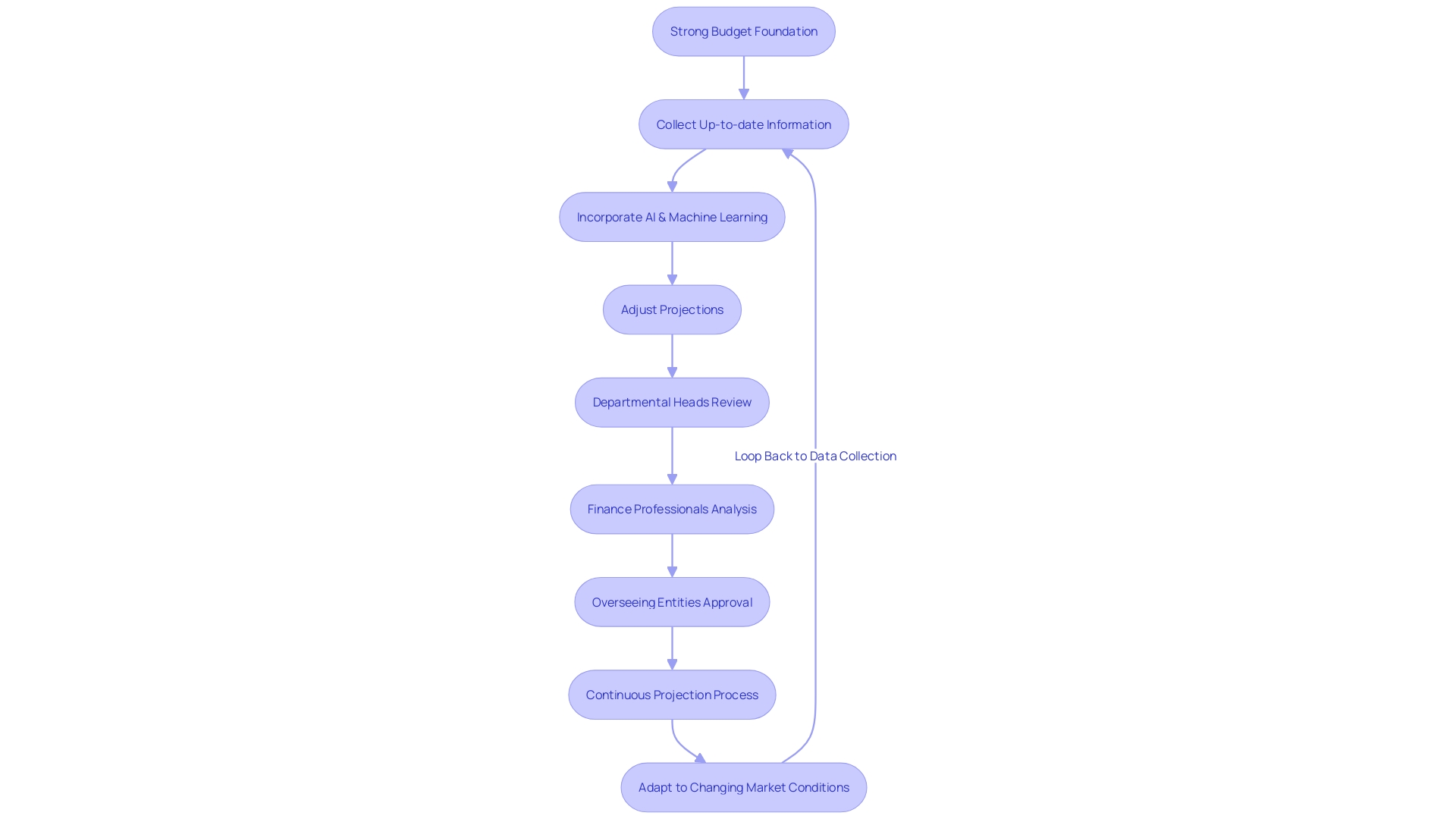
Key Components of a Rolling Forecast
A valuable rolling prediction is a necessary instrument for supply chain stakeholders and planners, and incorporating specific crucial components can greatly improve its precision and usefulness. Start with a comprehensive analysis of historical economic data, which provides the basis for identifying trends and establishing a reference point for future projections. It's crucial to clearly articulate the assumptions and drivers that support your future projections. These should be carefully researched and account for both internal and external factors that influence monetary outcomes.
Creating a detailed revenue projection necessitates comprehending market demand, pricing strategies, and consumer behavior—all essential in predicting future sales performance. Similarly, projecting future expenses demands an analysis of historical spending, strategic initiatives, and any identified avenues for cost reduction. Importantly, the interaction of revenue and expense predictions must be analyzed from the perspective of cash flow projections to protect against liquidity issues and preserve health.
Incorporate scenario analysis to evaluate how various circumstances might affect financial stability. This approach aligns with the insights from Nicolas Vandeput’s blog, which emphasizes the limitations of traditional forecasting methods in adapting to real-world events and the dynamic nature of markets. Incorporating real-time information and external events, as demonstrated by ECMWF's integration of advanced techniques like machine learning, can improve forecasting models.
Staying abreast of the latest forecasting techniques is paramount. The European Centre for Medium-Range Weather Forecasts (ECMWF) showcases the potential of machine learning in optimizing data assimilation for more accurate forecasting. In a similar vein, artificial intelligence (AI) is revolutionizing the forecasting domain, providing real-time insights and more precise predictions than conventional methods, which are often constrained by their slower analytical processes.
In the end, the objective is to guarantee that predictions are not just indicative of possible futures but also adjust to shifting circumstances, offering businesses with the strategic foresight required to prosper in an unpredictable economic landscape.
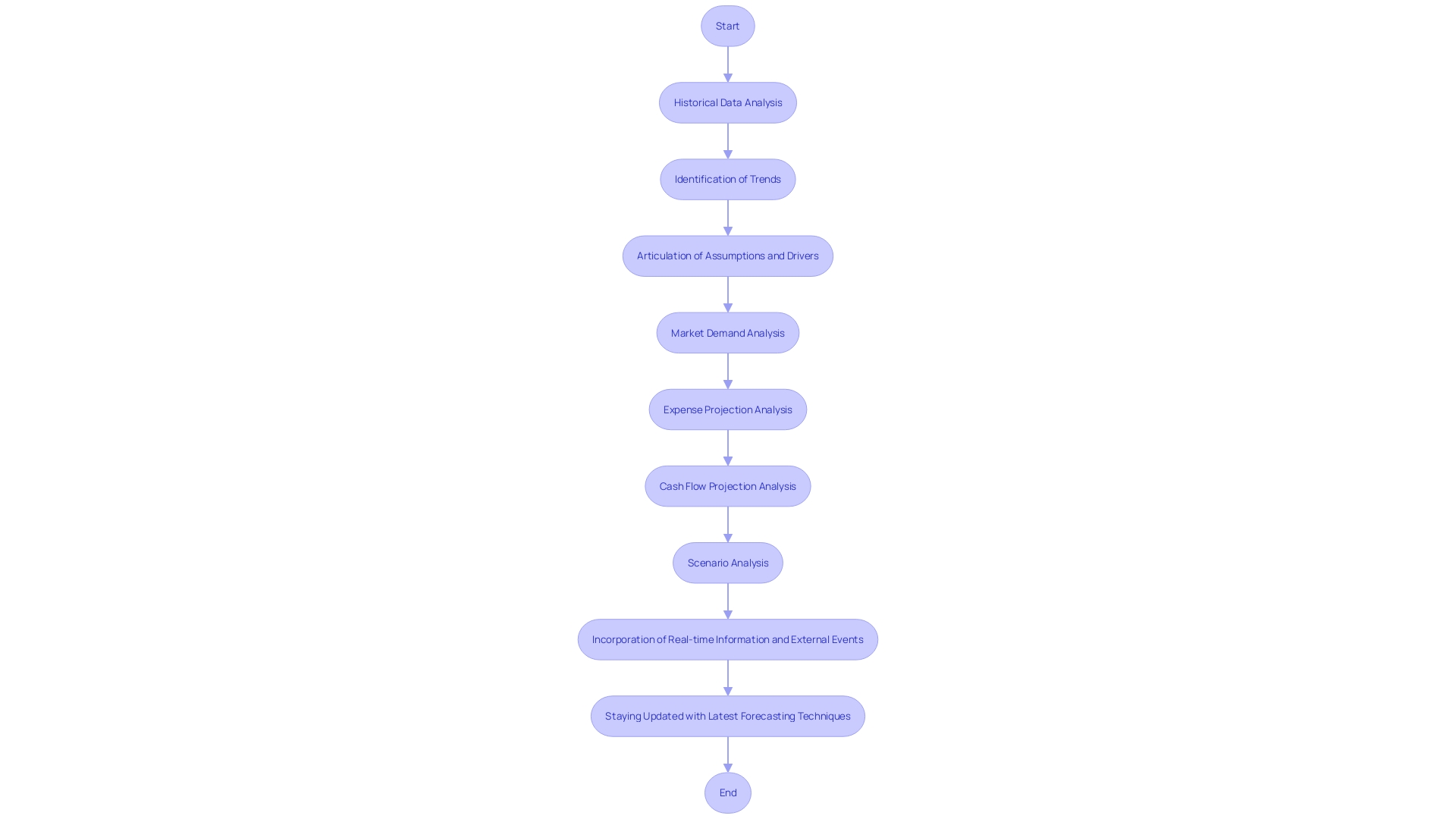
Choosing the Right Time Horizon
The skill of establishing a successful rolling projection is based on the choice of an appropriate time frame that aligns with the business's operational tempo and industry dynamics. Here's how to optimize your forecast's time frame:
-
Rapidly Evolving Industries: For industries that are subject to swift changes, like technology or retail, a shorter time horizon for forecasts is prudent. Monthly or quarterly updates can capture the volatility and enable timely responses to market fluctuations.
-
Capital-Intensive Industries: Companies engaged in industries with longer production cycles, such as manufacturing or utilities, find value in extending their forecasting time horizon. Annual or multi-year predictions allow for strategic planning around large capital expenditures and long-term investments.
-
Achieving a Balance Between Accuracy and Flexibility: It is essential to discover a compromise where the prediction is neither too unpredictable due to a very limited time frame nor too inflexible stemming from an excessively prolonged one. A well-calibrated time horizon ensures that the prediction remains a reliable tool for decision-making.
Incorporating these considerations into your forecasting strategy can help in maintaining a delicate equilibrium between supply and demand. It also allows businesses to navigate the complexities of sales and operations planning, where traditional point forecasting methods might fall short in accuracy. Instead, a rolling projection offers a more dynamic and adaptable approach, keeping in mind the necessity for precise prediction to stay ahead in competitive markets.
Utilizing robust statistical methods and econometric models, such as ARIMA and Exponential Smoothing, further refines the forecasting process. These techniques, backed by rigorous training and consultancy services provided by industry leaders, assist businesses in enhancing the efficiency of their supply chains and making data-driven financial and marketing decisions.
Furthermore, current data from the Industrial Production report and other economic surveys highlight the significance of consistent, well-investigated predictions. They not only serve as a guide for policymakers but also ensure that businesses are well-equipped to handle the future's uncertainties. With over thirty years of experience in the field, experts emphasize the significance of a systematic approach and intellectual rigor in forecasting, highlighting its role as a central task in shaping a better future for businesses.
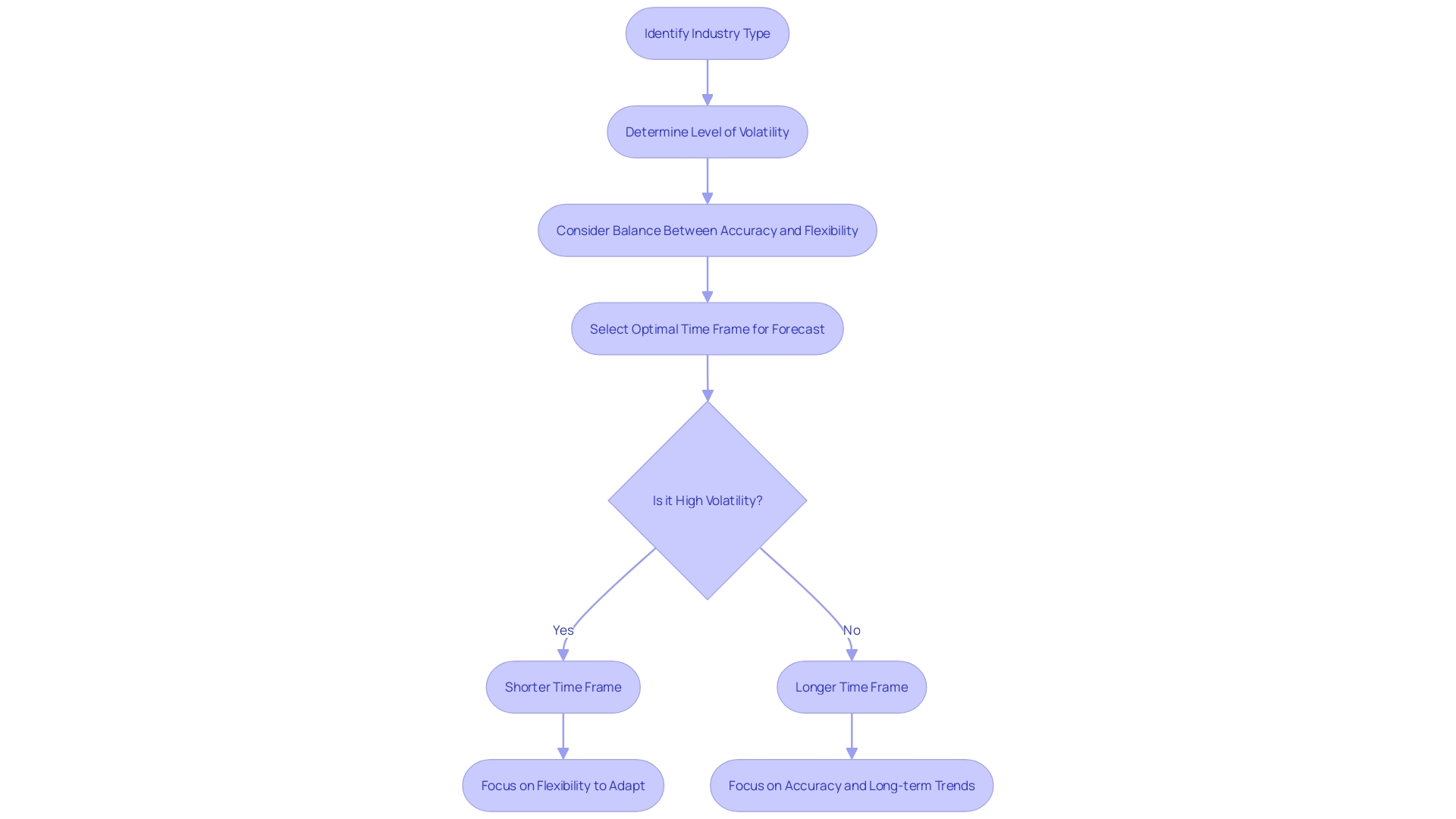
Determining the Update Frequency
Improving the frequency of updating a continuous prediction is a strategic choice that can have important consequences for supply chain stakeholders. In the field of supply chain management, where the objective is to maintain a balance between the risks of having too much or too little supply, the timing of prediction updates is crucial. Updating too infrequently may result in missed opportunities and stockouts, while too frequent updates can strain resources.
To determine the optimal update frequency, a business should consider several factors:
-
Data Availability: A rolling forecast is only as good as the data that feeds it. Ensure timely access to high-quality information is achievable. This could mean streamlining the information gathering process or setting up efficient information sharing systems.
-
Decision-Making Cycles: The frequency of prediction updates should be in sync with the organization's strategic decision-making cycles. 'This alignment ensures that the most recent information informs critical business decisions.'.
-
Resource Constraints: The availability of human and time resources will impact the feasibility of updating predictions. While frequent updates can offer finer control, they also require more labor and time. Companies must weigh the benefits against the resource cost.
Innovative forecasting methods, such as those leveraging AI, are transforming traditional forecasting by providing real-time insights and greater accuracy by analyzing extensive data points, including social media behavior and historical purchases. These modern approaches offer a competitive edge by enabling quicker responses to market changes, as highlighted by organizations like Timberlake Consultants, which emphasize practical, data-driven training. As we step into 2023 and beyond, businesses are increasingly recognizing the value of harnessing AI for forecasting to anticipate market movements, customer behaviors, and trends more accurately.
In the end, the determination of the frequency at which to revise a continuous prediction should be influenced by the objective of generating actual worth for the company, considering both the measurable advantages and the resources made available by the prediction process. This strategic approach to forecasting empowers businesses to navigate the complexities of supply and demand effectively.
Implementing a Rolling Forecast
To efficiently construct and utilize a future projection, it is crucial to start with a transparent plan. The process begins by establishing distinct goals, shaping the rolling projection to function as a strategic instrument for decision-making rather than solely a financial statement. It's crucial to create a timeline that details key milestones and deliverables, keeping the implementation on schedule and under control.
Stakeholder engagement cannot be emphasized enough; involving department heads, finance teams, and top management ensures that the prediction reflects a comprehensive understanding of the organization's operations. The development of a projection template should be customized to match specific organizational requirements, using efficient tools that may vary from advanced FP&A software to adaptable Excel templates.
Education plays a crucial role in the success of the ongoing prediction. Users must be trained not only on the mechanics of the template but also on the strategic rationale behind the assumptions made for future projections. Since the constantly updated prediction is an active instrument, it requires continuous focus—ongoing surveillance enables immediate modifications based on the most recent information, and regular evaluation against real results aids in identifying areas for improvement.
In the context of supply chain management, where the accuracy of inventory projection is a recurring challenge, the principles of developing a rolling estimation can be particularly beneficial. With a prediction that is both responsive and dynamic, businesses can navigate the fine line between oversupply and undersupply, thus optimizing inventory levels geographically and maximizing profitability.
The ultimate objective of any prediction, as emphasized by professionals in the field of information science, is to produce tangible benefits for the organization. This could manifest in cost reductions, revenue growth, or the efficient allocation of time and resources. By maintaining the emphasis on value creation, instead of solely on prediction precision, the forecasting process is aligned with the wider business strategy.
Incorporating the latest advancements in technology, such as AI and machine learning, can enhance the forecasting process by providing real-time information and insights. This approach not only accelerates the forecasting cycle but also offers a competitive edge by enabling more informed decision-making.
In general, the execution of a continuous prediction is not just a task in financial management but a strategic effort that, when carried out with accuracy and foresight, can greatly contribute to an organization's flexibility and achievement.

Best Practices for Rolling Forecasts
Improving the ongoing prediction procedure is not only about careful preparation; it's a strategic maneuver that integrates data science, stakeholder engagement, and continuous evolution to adapt to market dynamics and operational demands. Here are some recommended best practices to enhance your rolling forecasts:
-
Regular Stakeholder Communication: Engage consistently with stakeholders, ensuring that updates and outcomes of the rolling forecasts are clearly communicated. This practice supports informed decision-making and keeps all parties aligned with the monetary trajectory of the organization.
-
Continuous Improvement: Embrace a culture of iterative improvement. Use feedback and the latest analytical techniques, such as Time Series Forecasting methods like ARIMA and Exponential Smoothing, to refine forecasting models. This can significantly boost the precision of predictions, impacting everything from inventory management to financial strategy.
-
Collaborative Approach: Encourage a synergistic environment where finance teams work closely with other departments. This approach utilizes diverse insights and aligns the projection with overarching business objectives, ensuring a cohesive strategy that resonates across the organization.
-
Sensitivity Analysis: Implement sensitivity analysis to gauge the effects of variable changes on forecasts. This analysis can uncover the monetary consequences of various situations, enabling a proactive rather than reactive approach to monetary planning.
-
Scenario Planning: Integrate scenario planning into your forecasting to anticipate various future states and their potential impacts on the organization's financial health. This strategic foresight is invaluable for navigating uncertainties and keeping the business resilient.
-
Review and Validation: Regularly compare the ongoing projection with actual performance. This not only emphasizes differences but also notifies modifications to future predictions, improving their precision and significance.
By implementing these effective techniques, organizations can transform their ongoing projections into a flexible instrument for strategic planning. It's about creating value beyond mere accuracy; it's about shaping a responsive and agile financial strategy that anticipates and adapts to the ever-changing business landscape.
Common Challenges and Solutions
Implementing rolling forecasts involves navigating through several challenges to ensure robust and reliable planning. One crucial aspect is preserving the quality and accessibility of information. To address this, it's paramount to establish comprehensive data collection and validation processes. For instance, companies that oversee geographically varied inventories must make precise predictions to avoid excess supply or insufficient supply, which can have a substantial effect on profits and customer satisfaction.
Change management is another hurdle, with resistance often stemming from a lack of understanding or fear of the unknown. To mitigate this, it's essential to involve stakeholders in the process, employ clear communication strategies, and provide thorough training. A case in point is the transformation program launched by Rolls-Royce, which focused on building a high-performing, resilient business. They recognized the role of their workforce and the importance of partnerships in creating sustainable growth.
Precision in predictions continues to be a constant hurdle. It's not just about the statistical methods, such as moving averages or linear regression, but also about the reconciliation of different measures and the consideration of uncertainties. Continuous refinement of forecasting techniques, alongside incorporating stakeholder feedback, is vital for improving accuracy over time. A scientist's perspective emphasizes that the value created by forecasts is paramount, transcending mere accuracy.
Furthermore, integration with existing financial systems and information sources is essential for consistency. As companies like the European Center for Medium-Range Weather Forecasts (ECMWF) integrate machine learning with traditional assimilation techniques, it's clear that innovative approaches can enhance the forecasting ecosystem.
Finally, achieving the balance between detail and simplicity in prediction templates is essential for user-friendliness and comprehension. This equilibrium is vital throughout different planning timeframes, whether immediate alterations in employment data or long-range benchmarking predictions.
In summary, ongoing projections can serve as a flexible instrument for future-oriented planning, but they necessitate meticulous implementation, focus on specifics, and ongoing improvement.
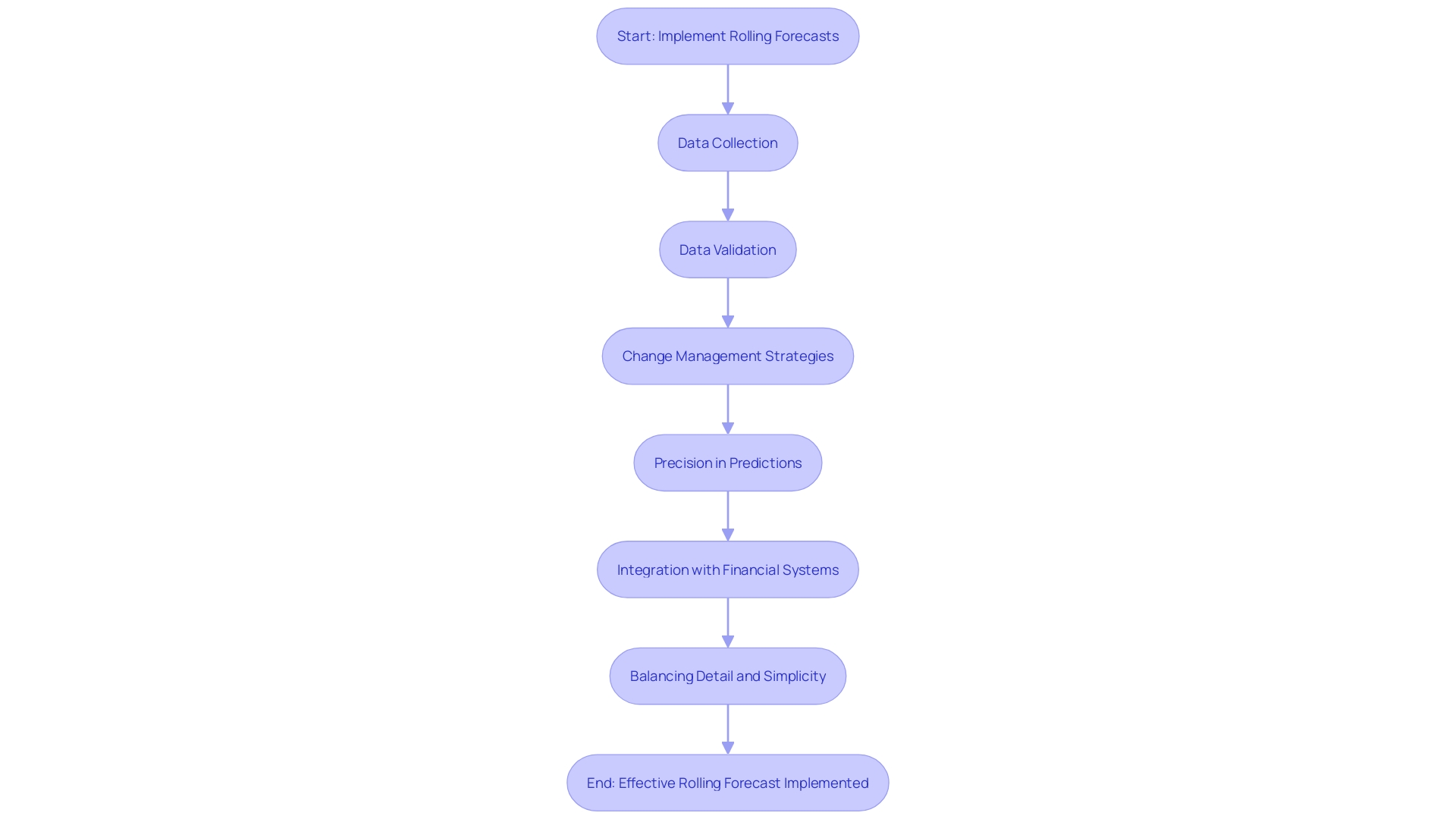
Using Dedicated FP&A Tools for Rolling Forecasts
By employing cutting-edge Financial Planning and Analysis (FP&A) tools, companies can transform their ongoing projection process. These advanced tools are designed to automatically integrate information, offer capabilities for detailed scenario modeling, and deliver immediate reporting. The advantages of deploying dedicated FP&A tools are manifold:
- Streamlined Process: By automating data collection and integration, these tools significantly minimize manual labor and decrease the likelihood of errors, thereby streamlining the rolling forecast workflow.
- Enhanced Collaboration: FP&A tools serve as a centralized hub, promoting collaborative efforts by offering a unified platform for data entry, analytical operations, and report generation.
- Advanced Analytics: With the inclusion of advanced analytics, these tools empower users with deeper insights and the ability to conduct thorough scenario analyses. The ability to generate immediate reports and dashboards is critical for monitoring the ongoing progress and performance of the real-time reporting.
In practice, companies have found innovative ways to employ forecasting tools tailored to their specific needs. For instance, firms running critical infrastructure with on-premise solutions have adopted Monte Carlo Simulations for more accurate scheduling and feature completion predictions. Similarly, a retail chain like Auchan Ukraine developed a forecasting model that could be adapted with minimal adjustments across different countries, streamlining their promotion strategy for food products across numerous stores.
As the economic landscape evolves, the use of FP&A tools in forecasting becomes increasingly integral to a company's ability to adapt and thrive. Organizations such as FD Technologies, which has broadened its service offerings beyond its original focus on derivatives, understand the value of rebranding and strategic expansion to stay ahead in the market. By announcing their full-year results in May 2024, FD Technologies demonstrates its commitment to transparency and strategic growth.
In summary, dedicated FP&A tools are not just about simplifying the forecasting process; they are about empowering organizations to make data-driven decisions, fostering collaboration, and enabling them to remain agile in a dynamic business environment.
Creating a Rolling Forecast Template in Excel
Excel, a tool known for its versatility, is especially skilled at creating future projection templates, an important instrument for foresight. Creating a rolling projection starts with defining time intervals. In Excel, columns become the visual representation of these periods, whether they are months, quarters, or another chosen cadence.
Next, historical financials are cataloged to provide a foundation from which future performance is projected. Excel's strong formula and calculation capabilities are then used to anticipate outcomes. These projections hinge on the underlying assumptions and factors that drive business performance.
To communicate the intricacies of the prediction, the charting and visualization tools in Excel convert information into easily understandable visual stories. This visual approach not only clarifies trends and patterns but also enables stakeholders to understand complex financial predictions with greater ease.
Ensuring the accuracy of the information is crucial. Data validation techniques serve as the gatekeepers of accuracy, maintaining the consistency necessary for reliable forecasting. The process doesn't end upon the initial creation of the ongoing prediction; continuous refinement is key. As actual performance information unfolds, the rolling forecast template is honed, incorporating feedback to capture the most accurate financial trajectory.
Recent updates to Excel have only enhanced its capabilities. Users can now synchronize form information directly to Excel for the web, insert images into cells on Windows and Mac versions, and leverage expanded PivotTable functionalities on iPad. These improvements further optimize the forecasting process, ensuring that the information stays connected to the visuals, even as the layout changes.
Excel's prowess is exemplified when handling extensive datasets, such as a superstore's four-year transaction records. With nearly 10,000 rows and over 20 columns, the information can be overwhelming. PivotTables come to the rescue, enabling users to distill vast amounts of information into actionable insights.
In this ever-evolving financial landscape, understanding trend analysis is invaluable. The average, a statistical tool that focuses on a specific subset of data points to predict future trends, is a prime example of Excel's utility. By calculating a 12-month average of sales, for instance, businesses can discern sales trends over the year.
For those looking to deepen their Excel expertise, resources abound. From beginner guides to advanced tutorials, the knowledge to master Excel's forecasting tools is readily available. Whether you are a seasoned user or new to quantitative methods, the path to mastering Excel's forecasting is one of continuous learning and adaptation.
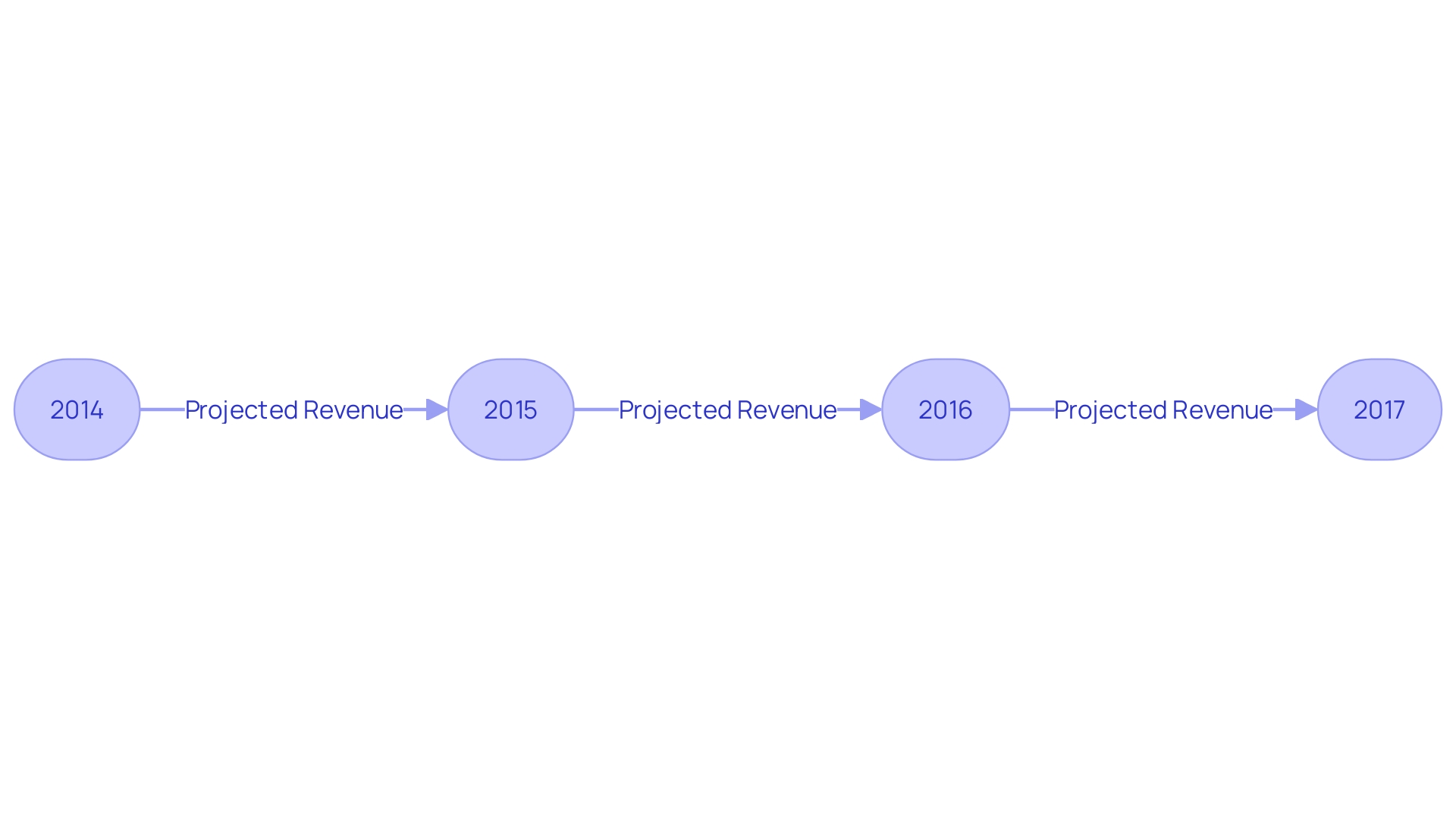
Integrating Actuals and Forecasts
To ensure that the performance of an organization's finances is accurately reflected, it is vital to blend actual monetary information with rolling predictions. This integration involves a multi-faceted approach:
-
Data reconciliation: It is essential to reconcile actual financial data with the forecasted figures meticulously. This step is crucial in identifying and understanding any discrepancies, which can significantly impact the investment decision-making process.
-
Variance analysis: Conducting a comprehensive variance analysis reveals the causes of discrepancies between actuals and projections. Recognizing that cultural change can be a significant barrier in data and analytics transformation, this analysis helps stakeholders understand the nuances of financial data.
-
Modifying predictions: Taking into account the knowledge acquired from real performance and discrepancy analysis, it is crucial to revise upcoming projection periods. This iterative process demonstrates a dedication to flexibility and guarantees that predictions stay pertinent and trustworthy.
-
Continuous monitoring: By continuously monitoring actual performance against the rolling projection, organizations can identify emerging trends. This proactive approach allows for timely adjustments in forecasts, aligning them with the current economic landscape.
These steps encapsulate a flexible and adaptable planning strategy, embracing new information types, and fostering a culture of change that prepares an organization for any economic climate.
Variance Analysis and Continuous Improvement
Variance analysis acts as the compass for navigating the economic seas, providing a systematic comparison of actual outcomes against forecasted data. Much more than a mere check-up, it illuminates the path for recalibration and strategic refinement. Here's the multi-faceted role it plays in elevating the rolling forecast process:
-
Pinpointing Discrepancies: By shedding light on deviations between expected and actual financial results, variance analysis surfaces potential challenges or opportunities ripe for exploration and action.
-
Deriving Insights from Divergences: The exploration into the 'why' behind the variances is a treasure trove of knowledge, offering a chance to enhance forecasting methodologies and fine-tune the underlying assumptions.
-
Informing Future Projections: Insights gleaned from variance analysis are not merely academic; they are instrumental in revising upcoming forecasts to better mirror real-world performance, thereby sharpening the accuracy of future financial projections.
-
Fostering a Dynamic Forecasting Cycle: The true power of variance analysis lies in its ability to feed continuous, actionable intelligence back into the forecasting process, ensuring it adapts and thrives amidst the ever-shifting business landscape.
Incorporating advanced tools like AI and machine learning can take variance analysis to new heights. These technologies expedite the analysis by processing vast amounts of data rapidly and with greater precision, ultimately delivering real-time insights that traditional methods could take weeks or months to unearth. Utilizing AI can be a game-changer, granting businesses the agility to stay ahead of the curve in today's fast-paced market.
Conclusion
In conclusion, rolling forecasts offer agility, accuracy, and visibility for financial planning in today's volatile economic landscape. By leveraging historical data and incorporating advanced AI forecasting techniques, businesses can adapt swiftly to changing markets, refine projections for greater accuracy, optimize resource allocation, and gain a clearer view of their financial trajectory.
Understanding rolling forecast templates is crucial, as they capture financial metrics and assumptions across various time periods, integrate seamlessly with existing financial systems, and allow for real-time adjustments. Key components such as robust analysis of historical financial data, clear articulation of assumptions and drivers, nuanced revenue and expense forecasts, and scenario analysis enhance the accuracy and utility of rolling forecasts.
Choosing the right time horizon and update frequency is essential, enabling businesses to balance risks and make data-driven financial decisions. Implementing a rolling forecast requires a clear blueprint, stakeholder engagement, tailored forecast templates, ongoing education, and continuous monitoring. Best practices such as regular stakeholder communication, continuous improvement, collaboration, sensitivity analysis, scenario planning, and review and validation enhance the effectiveness of rolling forecasts.
Using dedicated FP&A tools streamlines the process, enhances collaboration, provides advanced analytics, and enables real-time reporting. Excel is a versatile tool for creating rolling forecast templates, allowing for the integration of historical data, formulas, visualization tools, and continuous refinement.
Integrating actuals and forecasts ensures accurate reflection of financial performance through data reconciliation, variance analysis, adjusting forecasts based on insights gained, and continuous monitoring. Variance analysis plays a crucial role in refining the rolling forecast process and can be enhanced with advanced tools like AI and machine learning.
In summary, rolling forecasts provide agility, accuracy, and visibility for financial planning. By adopting best practices, leveraging advanced tools, and continuously refining the forecasting process, organizations can make data-driven decisions and thrive in today's ever-changing business environment.




